Case Study: SteelCo Architecture Positions
VerifiedAdded on 2023/01/11
|8
|2440
|49
AI Summary
This case study explores how SteelCo should structure its architecture function and the necessary positions. It provides insights into the number of architects needed for each position in the company's divisions. The case study also discusses the operating model of Multicorp and its strategic business units, the standardization of business processes, integration of data, and the IT landscape structure. Additionally, it examines the installed EA tool at Fincorp, its value to the company, and how it can be used to facilitate business and IT alignment.
Contribute Materials
Your contribution can guide someone’s learning journey. Share your
documents today.
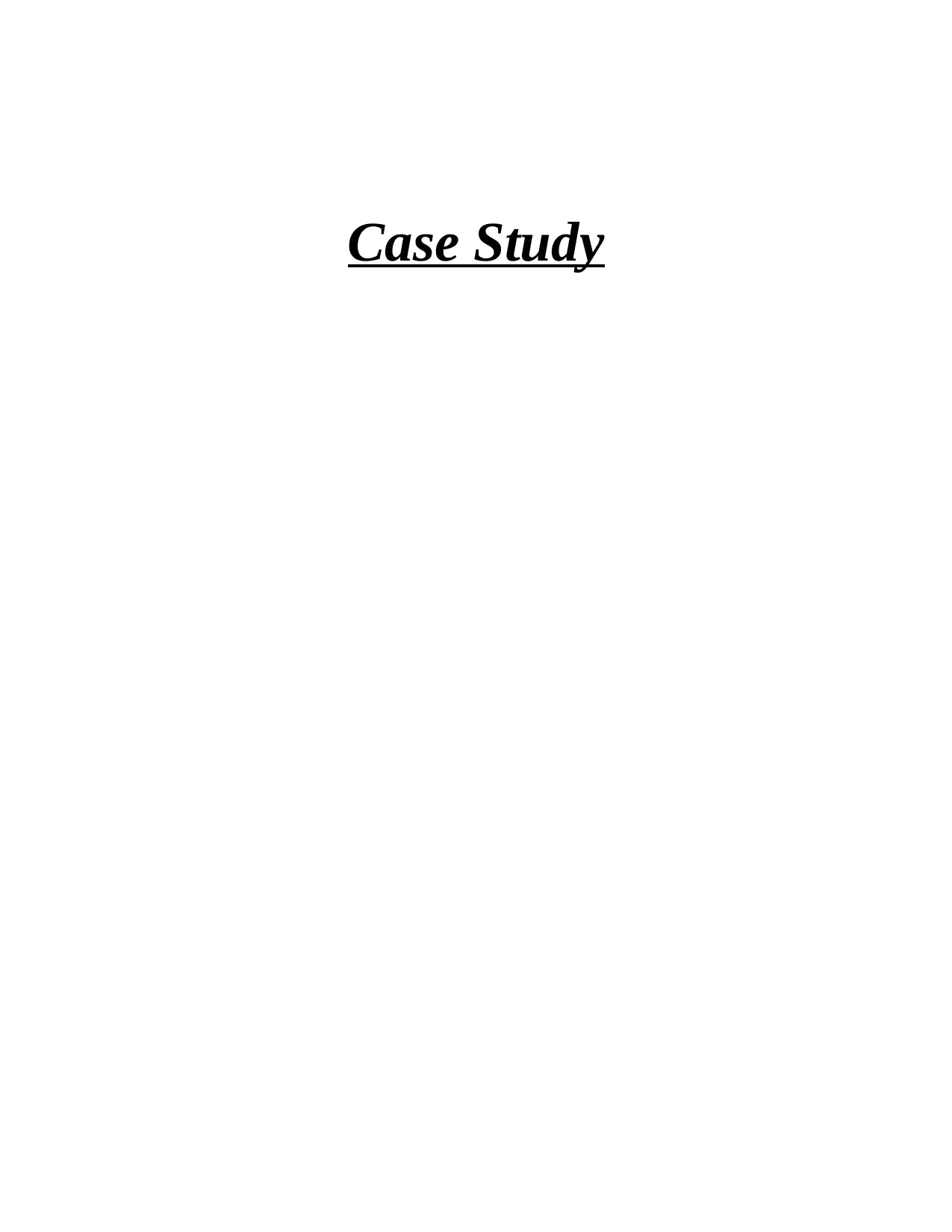
Case Study
Secure Best Marks with AI Grader
Need help grading? Try our AI Grader for instant feedback on your assignments.
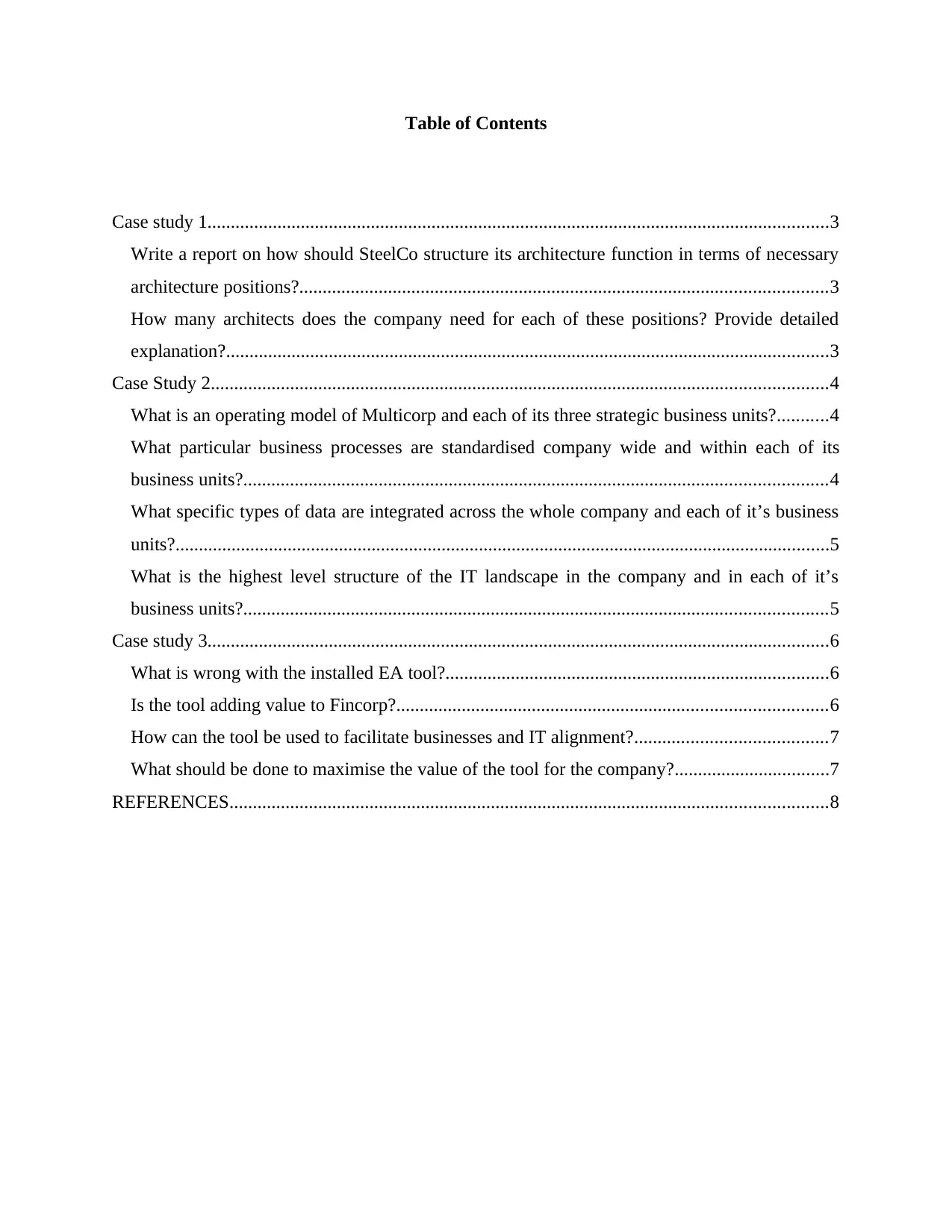
Table of Contents
Case study 1.....................................................................................................................................3
Write a report on how should SteelCo structure its architecture function in terms of necessary
architecture positions?.................................................................................................................3
How many architects does the company need for each of these positions? Provide detailed
explanation?.................................................................................................................................3
Case Study 2....................................................................................................................................4
What is an operating model of Multicorp and each of its three strategic business units?...........4
What particular business processes are standardised company wide and within each of its
business units?.............................................................................................................................4
What specific types of data are integrated across the whole company and each of it’s business
units?............................................................................................................................................5
What is the highest level structure of the IT landscape in the company and in each of it’s
business units?.............................................................................................................................5
Case study 3.....................................................................................................................................6
What is wrong with the installed EA tool?..................................................................................6
Is the tool adding value to Fincorp?............................................................................................6
How can the tool be used to facilitate businesses and IT alignment?.........................................7
What should be done to maximise the value of the tool for the company?.................................7
REFERENCES................................................................................................................................8
Case study 1.....................................................................................................................................3
Write a report on how should SteelCo structure its architecture function in terms of necessary
architecture positions?.................................................................................................................3
How many architects does the company need for each of these positions? Provide detailed
explanation?.................................................................................................................................3
Case Study 2....................................................................................................................................4
What is an operating model of Multicorp and each of its three strategic business units?...........4
What particular business processes are standardised company wide and within each of its
business units?.............................................................................................................................4
What specific types of data are integrated across the whole company and each of it’s business
units?............................................................................................................................................5
What is the highest level structure of the IT landscape in the company and in each of it’s
business units?.............................................................................................................................5
Case study 3.....................................................................................................................................6
What is wrong with the installed EA tool?..................................................................................6
Is the tool adding value to Fincorp?............................................................................................6
How can the tool be used to facilitate businesses and IT alignment?.........................................7
What should be done to maximise the value of the tool for the company?.................................7
REFERENCES................................................................................................................................8
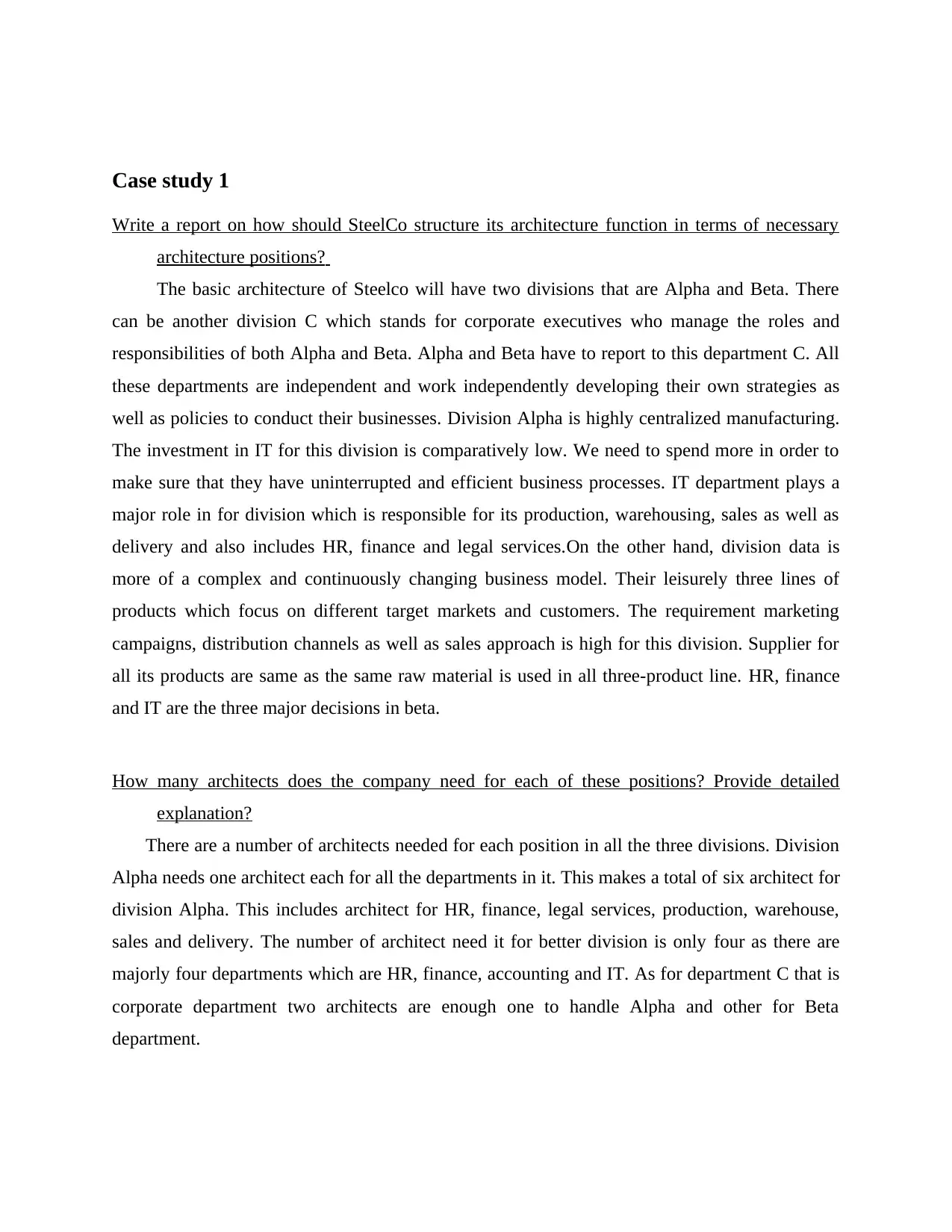
Case study 1
Write a report on how should SteelCo structure its architecture function in terms of necessary
architecture positions?
The basic architecture of Steelco will have two divisions that are Alpha and Beta. There
can be another division C which stands for corporate executives who manage the roles and
responsibilities of both Alpha and Beta. Alpha and Beta have to report to this department C. All
these departments are independent and work independently developing their own strategies as
well as policies to conduct their businesses. Division Alpha is highly centralized manufacturing.
The investment in IT for this division is comparatively low. We need to spend more in order to
make sure that they have uninterrupted and efficient business processes. IT department plays a
major role in for division which is responsible for its production, warehousing, sales as well as
delivery and also includes HR, finance and legal services.On the other hand, division data is
more of a complex and continuously changing business model. Their leisurely three lines of
products which focus on different target markets and customers. The requirement marketing
campaigns, distribution channels as well as sales approach is high for this division. Supplier for
all its products are same as the same raw material is used in all three-product line. HR, finance
and IT are the three major decisions in beta.
How many architects does the company need for each of these positions? Provide detailed
explanation?
There are a number of architects needed for each position in all the three divisions. Division
Alpha needs one architect each for all the departments in it. This makes a total of six architect for
division Alpha. This includes architect for HR, finance, legal services, production, warehouse,
sales and delivery. The number of architect need it for better division is only four as there are
majorly four departments which are HR, finance, accounting and IT. As for department C that is
corporate department two architects are enough one to handle Alpha and other for Beta
department.
Write a report on how should SteelCo structure its architecture function in terms of necessary
architecture positions?
The basic architecture of Steelco will have two divisions that are Alpha and Beta. There
can be another division C which stands for corporate executives who manage the roles and
responsibilities of both Alpha and Beta. Alpha and Beta have to report to this department C. All
these departments are independent and work independently developing their own strategies as
well as policies to conduct their businesses. Division Alpha is highly centralized manufacturing.
The investment in IT for this division is comparatively low. We need to spend more in order to
make sure that they have uninterrupted and efficient business processes. IT department plays a
major role in for division which is responsible for its production, warehousing, sales as well as
delivery and also includes HR, finance and legal services.On the other hand, division data is
more of a complex and continuously changing business model. Their leisurely three lines of
products which focus on different target markets and customers. The requirement marketing
campaigns, distribution channels as well as sales approach is high for this division. Supplier for
all its products are same as the same raw material is used in all three-product line. HR, finance
and IT are the three major decisions in beta.
How many architects does the company need for each of these positions? Provide detailed
explanation?
There are a number of architects needed for each position in all the three divisions. Division
Alpha needs one architect each for all the departments in it. This makes a total of six architect for
division Alpha. This includes architect for HR, finance, legal services, production, warehouse,
sales and delivery. The number of architect need it for better division is only four as there are
majorly four departments which are HR, finance, accounting and IT. As for department C that is
corporate department two architects are enough one to handle Alpha and other for Beta
department.
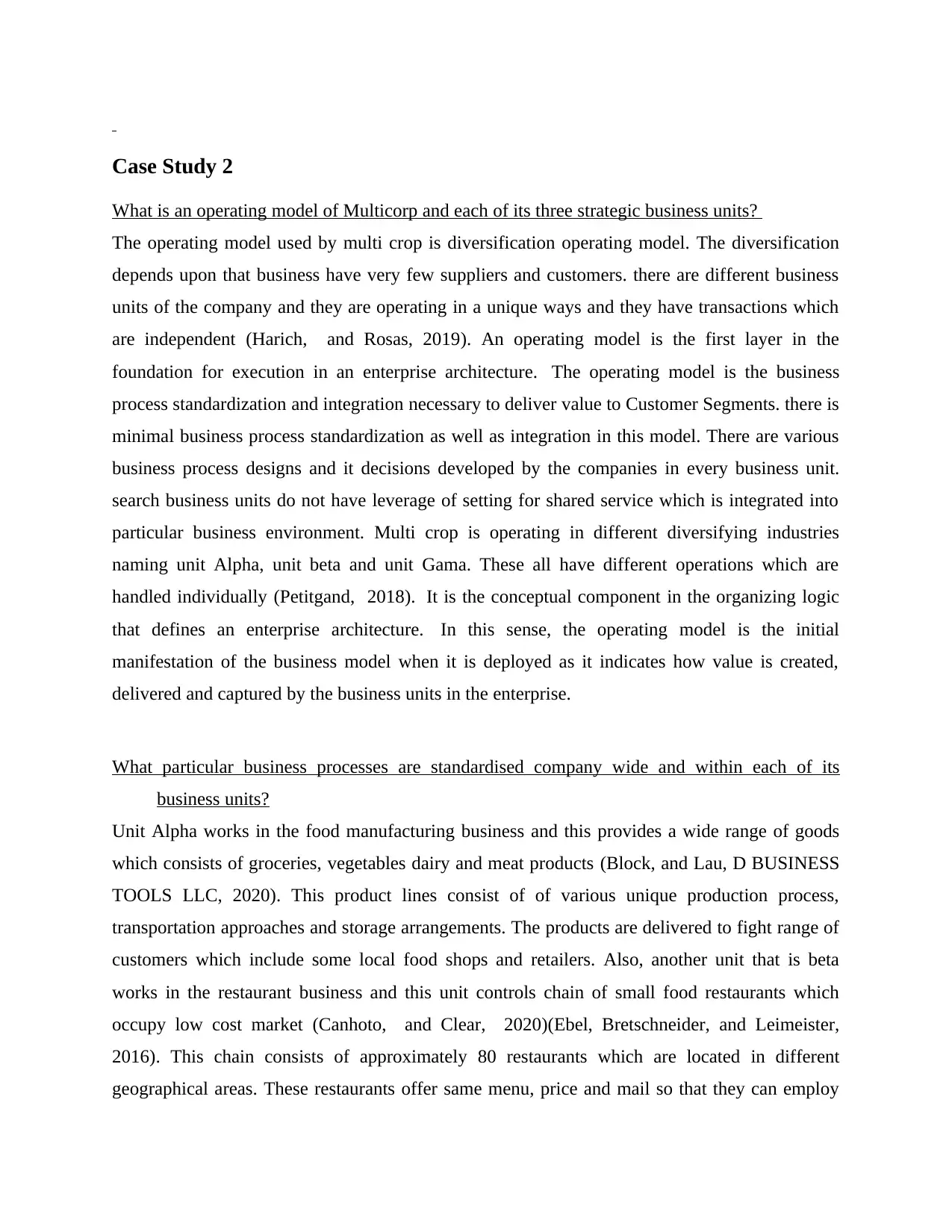
Case Study 2
What is an operating model of Multicorp and each of its three strategic business units?
The operating model used by multi crop is diversification operating model. The diversification
depends upon that business have very few suppliers and customers. there are different business
units of the company and they are operating in a unique ways and they have transactions which
are independent (Harich, and Rosas, 2019). An operating model is the first layer in the
foundation for execution in an enterprise architecture. The operating model is the business
process standardization and integration necessary to deliver value to Customer Segments. there is
minimal business process standardization as well as integration in this model. There are various
business process designs and it decisions developed by the companies in every business unit.
search business units do not have leverage of setting for shared service which is integrated into
particular business environment. Multi crop is operating in different diversifying industries
naming unit Alpha, unit beta and unit Gama. These all have different operations which are
handled individually (Petitgand, 2018). It is the conceptual component in the organizing logic
that defines an enterprise architecture. In this sense, the operating model is the initial
manifestation of the business model when it is deployed as it indicates how value is created,
delivered and captured by the business units in the enterprise.
What particular business processes are standardised company wide and within each of its
business units?
Unit Alpha works in the food manufacturing business and this provides a wide range of goods
which consists of groceries, vegetables dairy and meat products (Block, and Lau, D BUSINESS
TOOLS LLC, 2020). This product lines consist of of various unique production process,
transportation approaches and storage arrangements. The products are delivered to fight range of
customers which include some local food shops and retailers. Also, another unit that is beta
works in the restaurant business and this unit controls chain of small food restaurants which
occupy low cost market (Canhoto, and Clear, 2020)(Ebel, Bretschneider, and Leimeister,
2016). This chain consists of approximately 80 restaurants which are located in different
geographical areas. These restaurants offer same menu, price and mail so that they can employ
What is an operating model of Multicorp and each of its three strategic business units?
The operating model used by multi crop is diversification operating model. The diversification
depends upon that business have very few suppliers and customers. there are different business
units of the company and they are operating in a unique ways and they have transactions which
are independent (Harich, and Rosas, 2019). An operating model is the first layer in the
foundation for execution in an enterprise architecture. The operating model is the business
process standardization and integration necessary to deliver value to Customer Segments. there is
minimal business process standardization as well as integration in this model. There are various
business process designs and it decisions developed by the companies in every business unit.
search business units do not have leverage of setting for shared service which is integrated into
particular business environment. Multi crop is operating in different diversifying industries
naming unit Alpha, unit beta and unit Gama. These all have different operations which are
handled individually (Petitgand, 2018). It is the conceptual component in the organizing logic
that defines an enterprise architecture. In this sense, the operating model is the initial
manifestation of the business model when it is deployed as it indicates how value is created,
delivered and captured by the business units in the enterprise.
What particular business processes are standardised company wide and within each of its
business units?
Unit Alpha works in the food manufacturing business and this provides a wide range of goods
which consists of groceries, vegetables dairy and meat products (Block, and Lau, D BUSINESS
TOOLS LLC, 2020). This product lines consist of of various unique production process,
transportation approaches and storage arrangements. The products are delivered to fight range of
customers which include some local food shops and retailers. Also, another unit that is beta
works in the restaurant business and this unit controls chain of small food restaurants which
occupy low cost market (Canhoto, and Clear, 2020)(Ebel, Bretschneider, and Leimeister,
2016). This chain consists of approximately 80 restaurants which are located in different
geographical areas. These restaurants offer same menu, price and mail so that they can employ
Secure Best Marks with AI Grader
Need help grading? Try our AI Grader for instant feedback on your assignments.
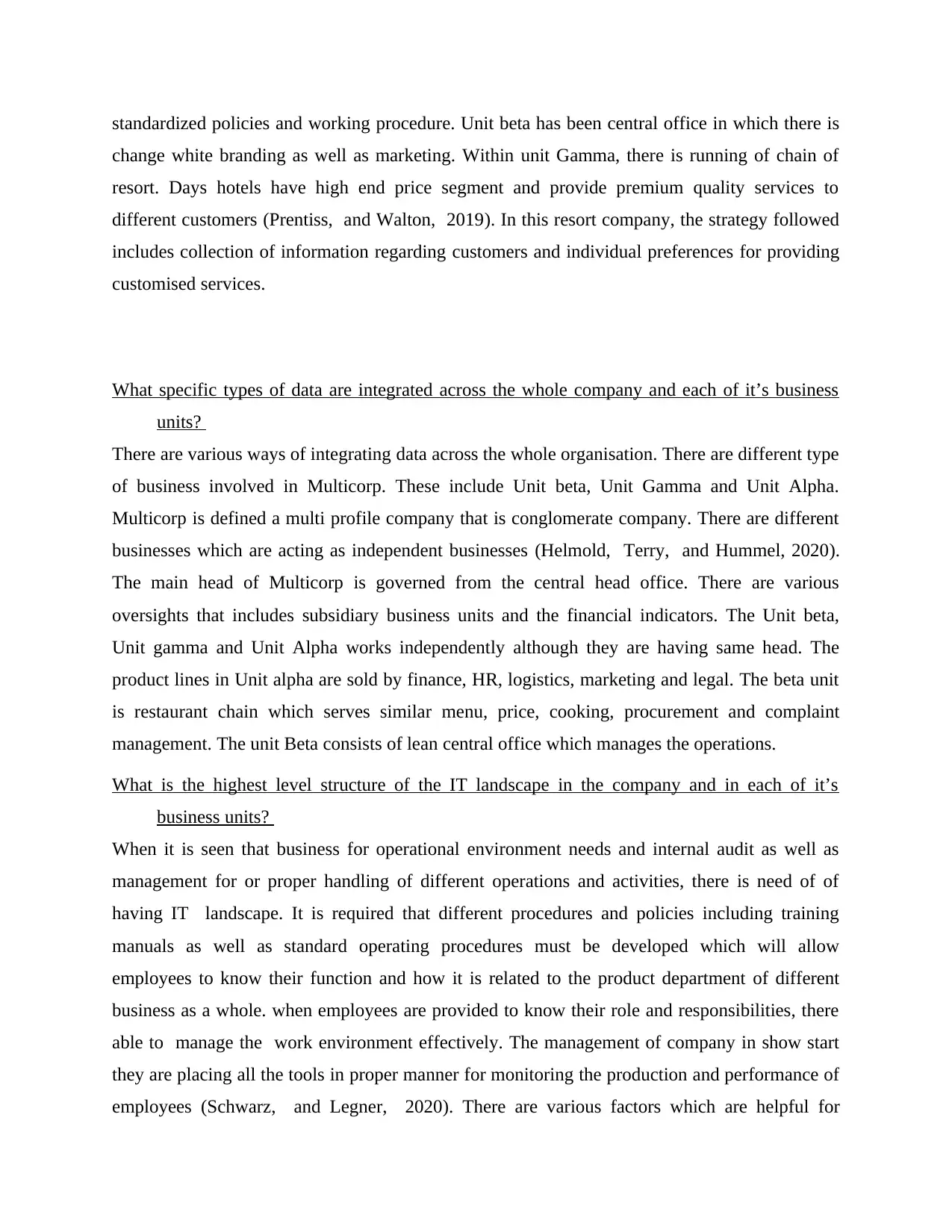
standardized policies and working procedure. Unit beta has been central office in which there is
change white branding as well as marketing. Within unit Gamma, there is running of chain of
resort. Days hotels have high end price segment and provide premium quality services to
different customers (Prentiss, and Walton, 2019). In this resort company, the strategy followed
includes collection of information regarding customers and individual preferences for providing
customised services.
What specific types of data are integrated across the whole company and each of it’s business
units?
There are various ways of integrating data across the whole organisation. There are different type
of business involved in Multicorp. These include Unit beta, Unit Gamma and Unit Alpha.
Multicorp is defined a multi profile company that is conglomerate company. There are different
businesses which are acting as independent businesses (Helmold, Terry, and Hummel, 2020).
The main head of Multicorp is governed from the central head office. There are various
oversights that includes subsidiary business units and the financial indicators. The Unit beta,
Unit gamma and Unit Alpha works independently although they are having same head. The
product lines in Unit alpha are sold by finance, HR, logistics, marketing and legal. The beta unit
is restaurant chain which serves similar menu, price, cooking, procurement and complaint
management. The unit Beta consists of lean central office which manages the operations.
What is the highest level structure of the IT landscape in the company and in each of it’s
business units?
When it is seen that business for operational environment needs and internal audit as well as
management for or proper handling of different operations and activities, there is need of of
having IT landscape. It is required that different procedures and policies including training
manuals as well as standard operating procedures must be developed which will allow
employees to know their function and how it is related to the product department of different
business as a whole. when employees are provided to know their role and responsibilities, there
able to manage the work environment effectively. The management of company in show start
they are placing all the tools in proper manner for monitoring the production and performance of
employees (Schwarz, and Legner, 2020). There are various factors which are helpful for
change white branding as well as marketing. Within unit Gamma, there is running of chain of
resort. Days hotels have high end price segment and provide premium quality services to
different customers (Prentiss, and Walton, 2019). In this resort company, the strategy followed
includes collection of information regarding customers and individual preferences for providing
customised services.
What specific types of data are integrated across the whole company and each of it’s business
units?
There are various ways of integrating data across the whole organisation. There are different type
of business involved in Multicorp. These include Unit beta, Unit Gamma and Unit Alpha.
Multicorp is defined a multi profile company that is conglomerate company. There are different
businesses which are acting as independent businesses (Helmold, Terry, and Hummel, 2020).
The main head of Multicorp is governed from the central head office. There are various
oversights that includes subsidiary business units and the financial indicators. The Unit beta,
Unit gamma and Unit Alpha works independently although they are having same head. The
product lines in Unit alpha are sold by finance, HR, logistics, marketing and legal. The beta unit
is restaurant chain which serves similar menu, price, cooking, procurement and complaint
management. The unit Beta consists of lean central office which manages the operations.
What is the highest level structure of the IT landscape in the company and in each of it’s
business units?
When it is seen that business for operational environment needs and internal audit as well as
management for or proper handling of different operations and activities, there is need of of
having IT landscape. It is required that different procedures and policies including training
manuals as well as standard operating procedures must be developed which will allow
employees to know their function and how it is related to the product department of different
business as a whole. when employees are provided to know their role and responsibilities, there
able to manage the work environment effectively. The management of company in show start
they are placing all the tools in proper manner for monitoring the production and performance of
employees (Schwarz, and Legner, 2020). There are various factors which are helpful for
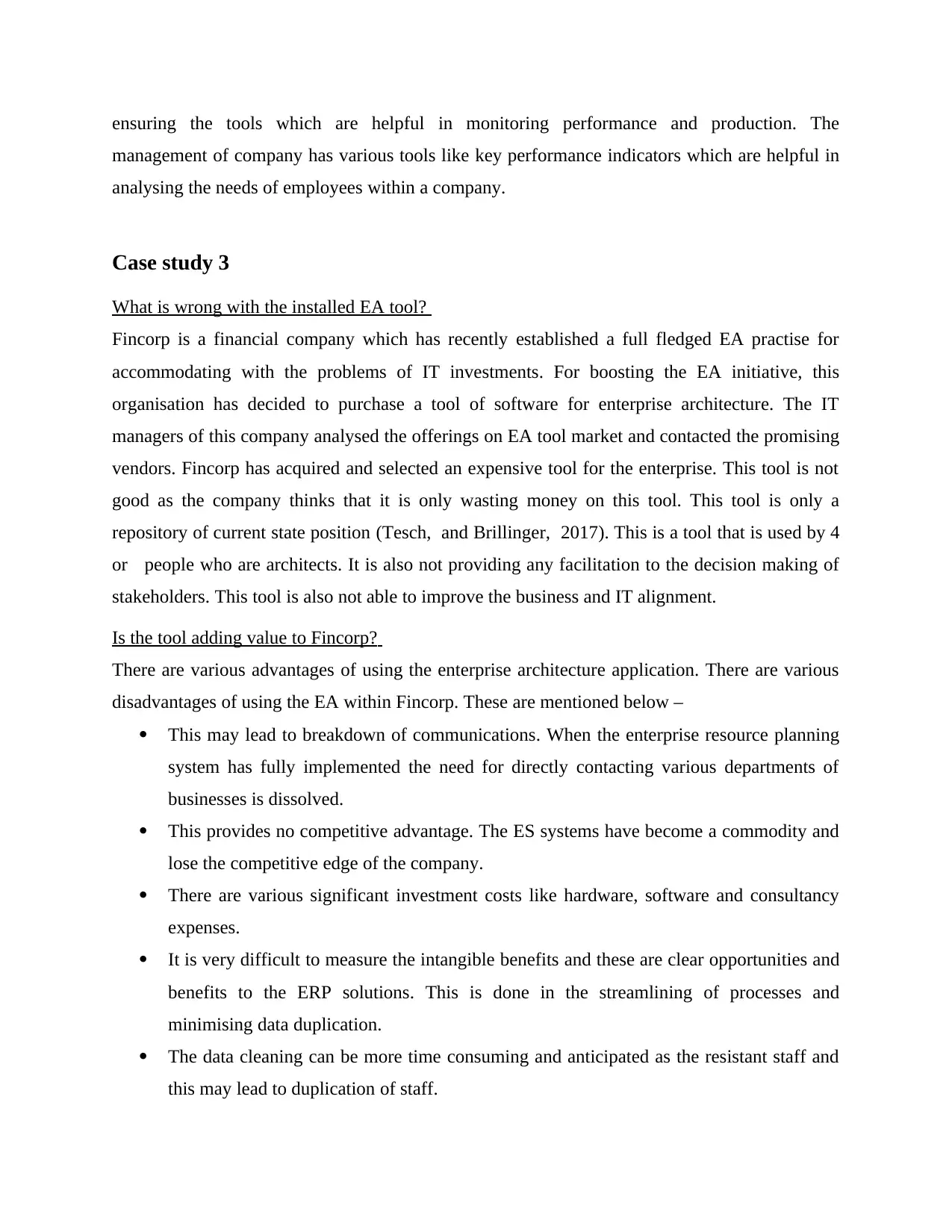
ensuring the tools which are helpful in monitoring performance and production. The
management of company has various tools like key performance indicators which are helpful in
analysing the needs of employees within a company.
Case study 3
What is wrong with the installed EA tool?
Fincorp is a financial company which has recently established a full fledged EA practise for
accommodating with the problems of IT investments. For boosting the EA initiative, this
organisation has decided to purchase a tool of software for enterprise architecture. The IT
managers of this company analysed the offerings on EA tool market and contacted the promising
vendors. Fincorp has acquired and selected an expensive tool for the enterprise. This tool is not
good as the company thinks that it is only wasting money on this tool. This tool is only a
repository of current state position (Tesch, and Brillinger, 2017). This is a tool that is used by 4
or people who are architects. It is also not providing any facilitation to the decision making of
stakeholders. This tool is also not able to improve the business and IT alignment.
Is the tool adding value to Fincorp?
There are various advantages of using the enterprise architecture application. There are various
disadvantages of using the EA within Fincorp. These are mentioned below –
This may lead to breakdown of communications. When the enterprise resource planning
system has fully implemented the need for directly contacting various departments of
businesses is dissolved.
This provides no competitive advantage. The ES systems have become a commodity and
lose the competitive edge of the company.
There are various significant investment costs like hardware, software and consultancy
expenses.
It is very difficult to measure the intangible benefits and these are clear opportunities and
benefits to the ERP solutions. This is done in the streamlining of processes and
minimising data duplication.
The data cleaning can be more time consuming and anticipated as the resistant staff and
this may lead to duplication of staff.
management of company has various tools like key performance indicators which are helpful in
analysing the needs of employees within a company.
Case study 3
What is wrong with the installed EA tool?
Fincorp is a financial company which has recently established a full fledged EA practise for
accommodating with the problems of IT investments. For boosting the EA initiative, this
organisation has decided to purchase a tool of software for enterprise architecture. The IT
managers of this company analysed the offerings on EA tool market and contacted the promising
vendors. Fincorp has acquired and selected an expensive tool for the enterprise. This tool is not
good as the company thinks that it is only wasting money on this tool. This tool is only a
repository of current state position (Tesch, and Brillinger, 2017). This is a tool that is used by 4
or people who are architects. It is also not providing any facilitation to the decision making of
stakeholders. This tool is also not able to improve the business and IT alignment.
Is the tool adding value to Fincorp?
There are various advantages of using the enterprise architecture application. There are various
disadvantages of using the EA within Fincorp. These are mentioned below –
This may lead to breakdown of communications. When the enterprise resource planning
system has fully implemented the need for directly contacting various departments of
businesses is dissolved.
This provides no competitive advantage. The ES systems have become a commodity and
lose the competitive edge of the company.
There are various significant investment costs like hardware, software and consultancy
expenses.
It is very difficult to measure the intangible benefits and these are clear opportunities and
benefits to the ERP solutions. This is done in the streamlining of processes and
minimising data duplication.
The data cleaning can be more time consuming and anticipated as the resistant staff and
this may lead to duplication of staff.
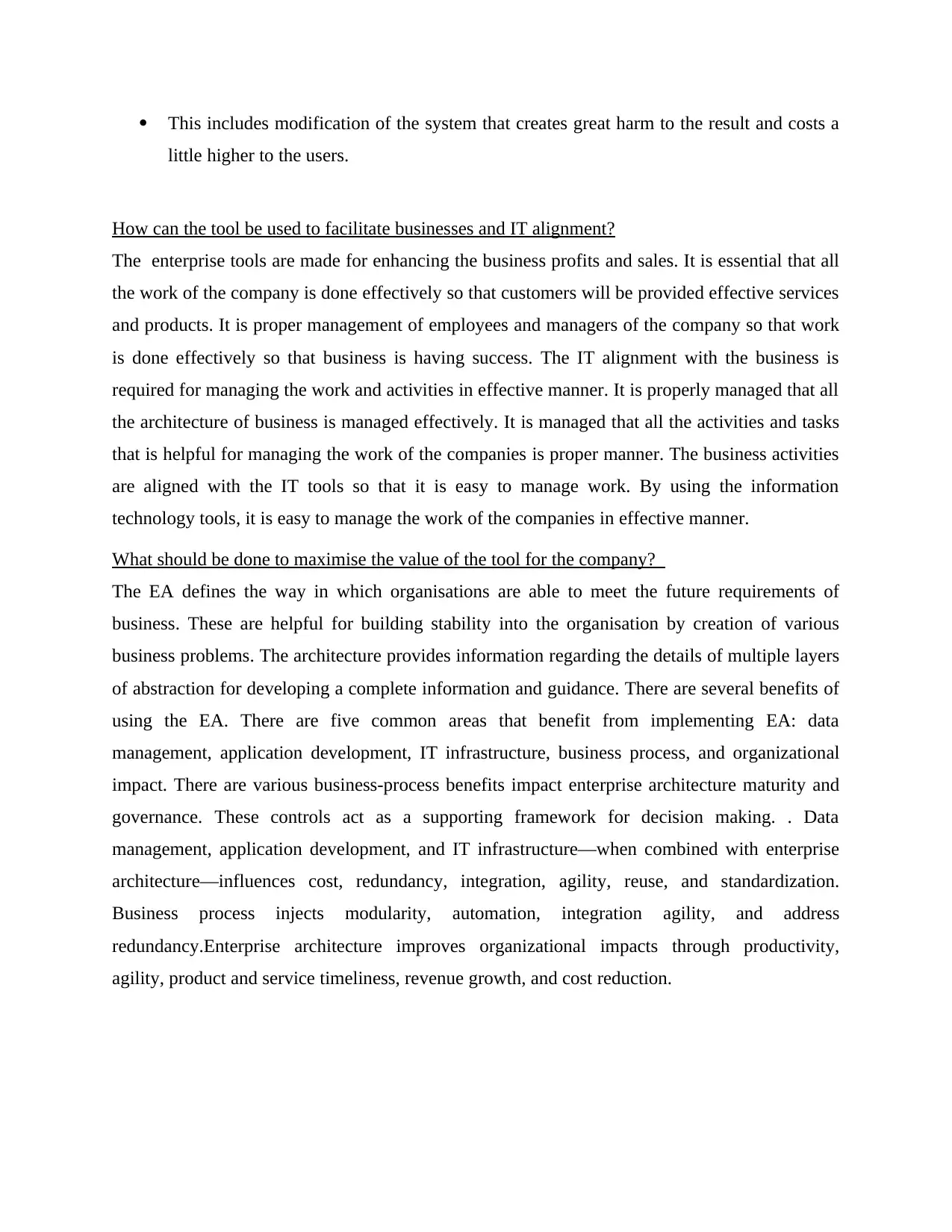
This includes modification of the system that creates great harm to the result and costs a
little higher to the users.
How can the tool be used to facilitate businesses and IT alignment?
The enterprise tools are made for enhancing the business profits and sales. It is essential that all
the work of the company is done effectively so that customers will be provided effective services
and products. It is proper management of employees and managers of the company so that work
is done effectively so that business is having success. The IT alignment with the business is
required for managing the work and activities in effective manner. It is properly managed that all
the architecture of business is managed effectively. It is managed that all the activities and tasks
that is helpful for managing the work of the companies is proper manner. The business activities
are aligned with the IT tools so that it is easy to manage work. By using the information
technology tools, it is easy to manage the work of the companies in effective manner.
What should be done to maximise the value of the tool for the company?
The EA defines the way in which organisations are able to meet the future requirements of
business. These are helpful for building stability into the organisation by creation of various
business problems. The architecture provides information regarding the details of multiple layers
of abstraction for developing a complete information and guidance. There are several benefits of
using the EA. There are five common areas that benefit from implementing EA: data
management, application development, IT infrastructure, business process, and organizational
impact. There are various business-process benefits impact enterprise architecture maturity and
governance. These controls act as a supporting framework for decision making. . Data
management, application development, and IT infrastructure—when combined with enterprise
architecture—influences cost, redundancy, integration, agility, reuse, and standardization.
Business process injects modularity, automation, integration agility, and address
redundancy.Enterprise architecture improves organizational impacts through productivity,
agility, product and service timeliness, revenue growth, and cost reduction.
little higher to the users.
How can the tool be used to facilitate businesses and IT alignment?
The enterprise tools are made for enhancing the business profits and sales. It is essential that all
the work of the company is done effectively so that customers will be provided effective services
and products. It is proper management of employees and managers of the company so that work
is done effectively so that business is having success. The IT alignment with the business is
required for managing the work and activities in effective manner. It is properly managed that all
the architecture of business is managed effectively. It is managed that all the activities and tasks
that is helpful for managing the work of the companies is proper manner. The business activities
are aligned with the IT tools so that it is easy to manage work. By using the information
technology tools, it is easy to manage the work of the companies in effective manner.
What should be done to maximise the value of the tool for the company?
The EA defines the way in which organisations are able to meet the future requirements of
business. These are helpful for building stability into the organisation by creation of various
business problems. The architecture provides information regarding the details of multiple layers
of abstraction for developing a complete information and guidance. There are several benefits of
using the EA. There are five common areas that benefit from implementing EA: data
management, application development, IT infrastructure, business process, and organizational
impact. There are various business-process benefits impact enterprise architecture maturity and
governance. These controls act as a supporting framework for decision making. . Data
management, application development, and IT infrastructure—when combined with enterprise
architecture—influences cost, redundancy, integration, agility, reuse, and standardization.
Business process injects modularity, automation, integration agility, and address
redundancy.Enterprise architecture improves organizational impacts through productivity,
agility, product and service timeliness, revenue growth, and cost reduction.
Paraphrase This Document
Need a fresh take? Get an instant paraphrase of this document with our AI Paraphraser
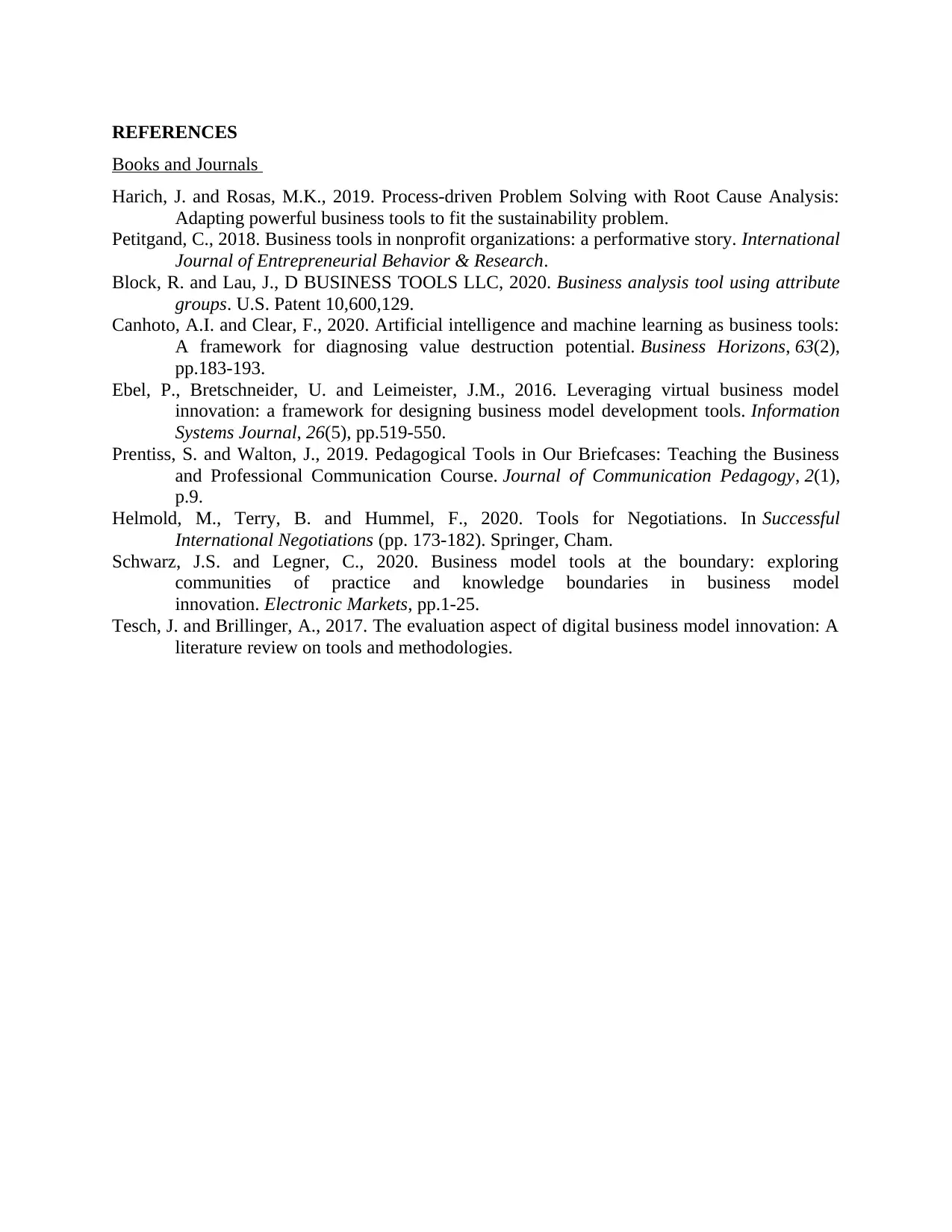
REFERENCES
Books and Journals
Harich, J. and Rosas, M.K., 2019. Process-driven Problem Solving with Root Cause Analysis:
Adapting powerful business tools to fit the sustainability problem.
Petitgand, C., 2018. Business tools in nonprofit organizations: a performative story. International
Journal of Entrepreneurial Behavior & Research.
Block, R. and Lau, J., D BUSINESS TOOLS LLC, 2020. Business analysis tool using attribute
groups. U.S. Patent 10,600,129.
Canhoto, A.I. and Clear, F., 2020. Artificial intelligence and machine learning as business tools:
A framework for diagnosing value destruction potential. Business Horizons, 63(2),
pp.183-193.
Ebel, P., Bretschneider, U. and Leimeister, J.M., 2016. Leveraging virtual business model
innovation: a framework for designing business model development tools. Information
Systems Journal, 26(5), pp.519-550.
Prentiss, S. and Walton, J., 2019. Pedagogical Tools in Our Briefcases: Teaching the Business
and Professional Communication Course. Journal of Communication Pedagogy, 2(1),
p.9.
Helmold, M., Terry, B. and Hummel, F., 2020. Tools for Negotiations. In Successful
International Negotiations (pp. 173-182). Springer, Cham.
Schwarz, J.S. and Legner, C., 2020. Business model tools at the boundary: exploring
communities of practice and knowledge boundaries in business model
innovation. Electronic Markets, pp.1-25.
Tesch, J. and Brillinger, A., 2017. The evaluation aspect of digital business model innovation: A
literature review on tools and methodologies.
Books and Journals
Harich, J. and Rosas, M.K., 2019. Process-driven Problem Solving with Root Cause Analysis:
Adapting powerful business tools to fit the sustainability problem.
Petitgand, C., 2018. Business tools in nonprofit organizations: a performative story. International
Journal of Entrepreneurial Behavior & Research.
Block, R. and Lau, J., D BUSINESS TOOLS LLC, 2020. Business analysis tool using attribute
groups. U.S. Patent 10,600,129.
Canhoto, A.I. and Clear, F., 2020. Artificial intelligence and machine learning as business tools:
A framework for diagnosing value destruction potential. Business Horizons, 63(2),
pp.183-193.
Ebel, P., Bretschneider, U. and Leimeister, J.M., 2016. Leveraging virtual business model
innovation: a framework for designing business model development tools. Information
Systems Journal, 26(5), pp.519-550.
Prentiss, S. and Walton, J., 2019. Pedagogical Tools in Our Briefcases: Teaching the Business
and Professional Communication Course. Journal of Communication Pedagogy, 2(1),
p.9.
Helmold, M., Terry, B. and Hummel, F., 2020. Tools for Negotiations. In Successful
International Negotiations (pp. 173-182). Springer, Cham.
Schwarz, J.S. and Legner, C., 2020. Business model tools at the boundary: exploring
communities of practice and knowledge boundaries in business model
innovation. Electronic Markets, pp.1-25.
Tesch, J. and Brillinger, A., 2017. The evaluation aspect of digital business model innovation: A
literature review on tools and methodologies.
1 out of 8
Related Documents
Your All-in-One AI-Powered Toolkit for Academic Success.
+13062052269
info@desklib.com
Available 24*7 on WhatsApp / Email
![[object Object]](/_next/static/media/star-bottom.7253800d.svg)
Unlock your academic potential
© 2024 | Zucol Services PVT LTD | All rights reserved.





